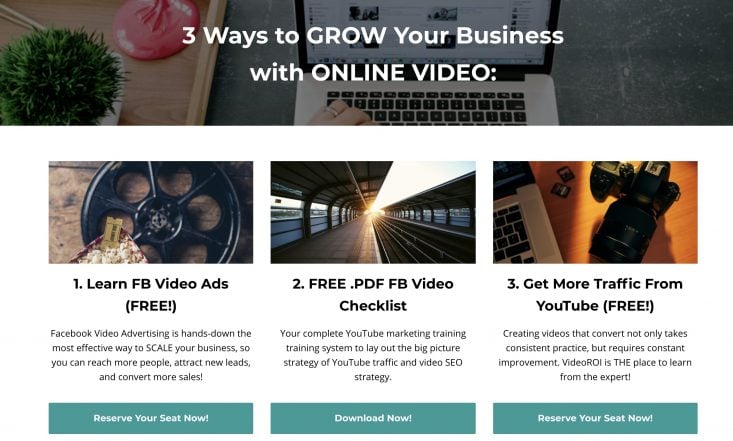Brand Identity: What It Is and How to Create One
Matthew Turner
Updated by Tara Malone
When it comes to brand identity, Coca-Cola has one of the strongest ones on the planet.
Coca-Cola’s branding is memorable, recognizable, powerful, and speaks to you on a subconscious level. It’s become synonymous with ordering a drink at a restaurant or bar. This doesn’t just happen. It’s a very intentional strategy. It’s a brand identity Coca-Cola has developed over decades.
It defines who they are as a business. And that’s the point.
Your brand is so important because it helps define who you are. It’s a visual representation of what you stand for and how you help those you serve. It helps create a new relationship with your potential customers and students.
It allows you to communicate who you are, what you stand for, and why you do what you do. And it helps you stand out from the crowd and sets you apart from the competition.
Curious about how to build an amazing brand identity of your own?
You’ve come to the right place!
In this guide, we’ll show you exactly how to build a winning brand identity for your business.
What is a Brand Identity?
Your brand identity consists of all the visible elements of your brand, including color, design, and even AI-generated logos. It’s how you present yourself as a business to the public. It’s also how you distinguish yourself from your competitors. In short, it’s what you say you are and it’s what your customers see.
Many elements go into a brand identity, including:
- Logo
- Colors
- Typography
- Design
- Photography
- Illustration
- Iconography
- Data visualization
- Interactive elements
- Video and motion
- Web design
It’s everything your customer sees and what you choose to share with the world. Many people believe it begins and ends with a logo. This simply is not the case.
Your logo plays a role, and an important one at that. Yet the brand identity you need goes much deeper.
How To Create a Brand Identity
So how do you create a successful brand identity?
In many ways, developing a brand identity is an art form. It’s difficult for one person to do it all on their own. There are agencies that specialize in building brand identities. It isn’t easy to achieve, yet at the same time, it’s a simple process to follow.
This journey begins with the most important step of all, aligning two different people so they can walk the same path: You and Your Customer.
Step 1: Define Your Audience and What You Stand For
Before you do anything else you must define who your customer is and what you stand for.
This often starts with understanding who it is that you actually serve.
- Who are they?
- What motivates them?
- Where are they?
- What’s their pain and/or problem?
- What are they passionate about?
- What are their strengths and weaknesses?
If you haven’t already done so, now is the time to create a customer profile (or avatar). We walk you through this process in a separate guide, which you may like to bookmark for later.
It’s important you start with your customer because this is who your brand serves. To an extent, it doesn’t matter what you stand for if you don’t appreciate who you’re serving. You can have the greatest message in the world, but what does it matter if nobody cares about it?
Define your audience. We’ll get to know them better next, but now is the time to decide who they are.
Once you have, you must reflect on yourself and your own business:
- What’s your big goal, purpose, and vision for the future?
- What do you strive to achieve? What’s your big promise to your customers?
- What’s your mission?
- What are your values?
- What’s your unique voice?
This not only allows you to complete many of the steps that come later in this process but also hone in on your unique selling proposition (USP). We’ve written a separate guide that dives into this, so you may also want to bookmark this one for later.
This all-important first step defines who you are as a brand and who it is that you serve. Beginning with these two important people sets you up for success later. It acts as a compass to direct you on your way, helping you make the right decision at times when you’re unsure what to choose.
Step 2: Research Your Audience
This second step follows on from the first, ensuring you get to know your audience on a deeper level. Once you create your customer profile, don’t think that’s the end. In the beginning, all you do is define who you’re serving.
Your job now is to get to know them.
Follow the steps in our customer profile guide and build out your avatar so you know:
- Who they are
- What they do
- Where they spend their time
- When they make decisions and take action
- Why they do what they do
Unearth their pain. Find out what their biggest problem is. Uncover the solution they need, not the one they want.
There are three main levels of pain:
- Surface Level Pain: the pain you’re aware of and like to focus on (i.e. I don’t have enough people buying my courses).
- Intellectual Pain: the pain you’re aware of but don’t like to focus on (i.e. I don’t have the cash flow to confidently pay my team for the next two months).
- Emotional Pain: the pain you’re likely unaware of but keeps you up all night (i.e. the worry that you’re not good enough to do this, and the fear that life will be like this forever).
You need to hone in on their emotional pain. This is what truly drives them forward, whether they like it or not. This is what will help them, and this is the problem you need to solve for them. But finding what this is takes research.
You need to observe your existing audience.
Observation often gives you the greatest insight. Not just observing your own audience, but your competitors, too (more on this next). Look at the Facebook comments people leave. Reflect on the questions they ask. Take another look at the emails people send you.
You might also arrange one-on-one phone calls with members of your audience. Ask them to complete a survey or questionnaire.
The point is, you need to get to know your audience. The better you know who you’re serving, the more impactful your brand identity will become.
Step 3: Analyze Your Competition
Once you’re clear on what you stand for and who you’re serving, you need to analyze your competitors. This not only generates new ideas for your own brand but introduces you to gaps in the market and potential opportunities.
There’s a fine line to analyzing your competition. Too much can sway you from your own UVP, leaving you trying to replicate what other brands are doing. Yet if you do too little you risk doing what you think is best without stepping into your audience’s shoes.
Find this balance by researching who your top competitors are based on their audience size/following, revenue, and traffic. Tools like SEMRush, Sprout Social, and BuzzSumo can help you discover this.
Once you have your main competitors, research them. Dive into their world!
- What’s their messaging like?
- What colors, design, and unique features do they use?
- Which platforms are they on?
- What are their values and what do they stand for?
- Where do they seem to find the most success?
All this allows you to measure what they do against what you’re doing (or plan to do). It helps you compare your own UVP against theirs. It gives you an insight into what works best in your industry and hopefully presents a few gaps in the market.
The point here isn’t to copy your competition or try to replicate them. Your aim is to gain greater insight into your industry so you can effectively place yourself inside it. This is important whether you’re just starting out or already established.
Unless you know, you do not know.
Take the time to complete this step. It’s one many people skip, yet doing this makes what comes next easier to achieve.
Step 4: Develop Your Brand Design

There are certain creative elements that go into your Brand Identity.
- Business Name: your name or the name of your business.
- Tagline/Slogan: your message, delivered in a sentence or two.
- Typography: the type of font you use in your branding.
- Color Palette: the colors you use, and the different shades.
- Shape/Form/Voice/Style: the different types of shapes you use or forms (curvy, straight, angular) and the style and voice of your messaging (the language you use, how you use it).
These act as the building blocks to your brand identity. Some of this will directly come from the work you do in Step One (defining who you are and what you stand for). Your values, mission, and purpose often help you create your tagline, slogan, and even your voice and style. After you define your brand mission, you must also create a business name that reflects your brand identity. Depending on your business structure, you can choose to operate as a DBA or LLC. Take a look at this guide by Small Business HQ to help you decide the best structure for your small business. And to learn all about setting up an LLC, check out LLC University.
Yet other elements need your attention right now. Whether you do this on your own or you work with a designer, it’s important to get clear on these building blocks. They direct everything that comes next, which is what brings your brand identity to life.
- Logo: the logo/badge that represents you in your designs.
- Website: your online home where you direct most of your audience.
- Packaging: how you package your different courses, products, and services.
- Messaging: the specific message you share, and how you use language, tone, voice, and copy to bring it all together.
If the previous elements act as your brand’s building blocks, these aspects form the foundation of your entire brand identity. This is what you share with the world. It’s the first impression your audience will have of you. It’s also how you differentiate yourself from your competitors.
At this stage, you’ll almost certainly have to work with other people: designers, copywriters, website developers. These people help you get out of your own head and make all your hard work a reality. They bring your values to life and give your purpose a voice. They visualize everything that you’ve created, thought of, and generated up to this point.
Once you have these core aspects you have everything you need for future marketing campaigns, email, ads, promotions, social media, and product launches, as well as the feel and look of your actual online courses.
Your brand identity is now real. It’s alive and ready for you to share with the world.
Step 5: Create a Brand Style Guide
A brand style guide is what helps you share your brand with the world. Right now, everything remains fresh in your mind. Yet as the weeks pass by, you may lose sight of the identity you’ve created.
This is why you need a guide. Not just for yourself, but as you grow your team and bring in new designers, writers, assistants, social media planners, and video editors. This guide directs them on what to use, how to use it, and what they must not use under any circumstances.
- Language: what words to use and which ones not to, as well as tone and style.
- Colors: the main colors to use, and the different shades to use under other circumstances.
- Typography/Fonts: what fonts to use and when.
- Images/Graphics: how to use headshots, logos, and other graphics.
Your brand guide ensures consistency. It makes sure you stick with the plan as well as anyone else who joins your team.
Consistency is key if your brand identity is to last the test of time. Your audience needs you to show up with a consistent message. Not just with your marketing, but also with your courses, community, and other services.
Your brand guide keeps you committed to this.
Step 6: Integrate Your Brand Identity with Your Community
At this stage of the process, your brand identity is real. It’s no longer an idea, but it’s out of your head and a part of the world. It’s an extension of you and your business, and it’s ready for you to use in your marketing, sales, and product/service design.
But before you do any of that you must ensure it integrates with your existing community(s):
- Online Courses
- Facebook Groups
- Social Media Platforms
- Membership Sites
- Mastermind Groups
Assuming you already have an existing audience, now is the time to introduce them to your brand identity. Let them see it before anyone else. Gather their feedback. Share the story behind the journey. Involve them in the process!
Not only will they help you evolve your brand identity, but they’ll become a part of it. It’s an important step you should not forget. Many people do, excited to bring in new leads and reach new people. Yet doing so places those you’ve already built a relationship with at the bottom of the pile.
It should be the other way around.
Treat those who are already part of your community as your most important people.
This is how you create a loyal customer base.
This is how you build a true community.
Step 7: Monitor Your Brand Identity
Whatever you build now is not the end. It must evolve!
You can only do this by monitoring your brand identity so you can determine which parts are successful and which aspects aren’t. For many things in business, this is simple. You can measure data, the hard facts.
It’s not as easy to achieve with your brand identity. But still not impossible.
In part, you can measure some hard statistics through:
- Website traffic
- Social media followers
- Social media engagements
- Landing page metrics
Yet a lot of this needs to involve your audience. As already mentioned in Step Two of this process, you can achieve a lot by observing those you serve. What questions do they ask? What messages do they engage with the most? Which platforms do they use the most?
You can take this further through customer surveys, questionnaires, and feedback. In fact, you must take it further if you want to truly evolve your brand identity. Make this an important, consistent part of your marketing. Speak to those you serve and ask them questions:
- How would you rate your experience with us?
- What makes us stand out from our competitors?
- What do you like the most about your brand?
- If you could change one thing about our brand, what would it be?
- How likely are you to recommend us to someone you know?
Monitoring and measuring your brand identity isn’t as easy to achieve as some other aspects of a business. Yet you cannot use this as an excuse. Your brand identity needs to evolve. Some of this happens organically as you get to know yourself and your audience better.
Yet most of it falls on your shoulders, as you intentionally strive to improve your brand.
4 Brand Identity Mistakes to Avoid

Your brand identity has the power to set you apart from your competitors. Implemented properly it can help you level up your success and build greater authority. However, there are some pitfalls you’ll need to avoid along the way.
Some of the biggest mistakes we see course creators make include:
1. Generic Logos
You need to stand out. Yes, you need to stay true to your style, values, and purpose. Yet you must create a logo design that catch’s a person’s attention in an instant. Attention levels are at an all-time low. You have a fraction of a second to stop someone from scrolling past you, possibly gone forever.
Your logo plays a giant role in this. It has to be unique and stand out.
Beyond your logo, your entire design and messaging must follow suit.
Be different. Be unique. Don’t look like everyone else in your industry.
2. Inconsistent Branding
We’ve already talked about the importance of consistency. A lack of it can destroy everything you build.
Your marketing messaging must remain consistent, as well as color schemes, designs, images, and everything else. Not just as you meet people and bring them into your funnel, but inside your community when they become one of your students.
Having a consistent brand identity is key to success.
Not just today or tomorrow… but far into the future.
3. Trying to Speak to Too Many People
You need to speak to someone – your ideal customer.
You cannot keep pivoting and changing your brand so it appeals to a more diverse crowd. All you achieve with this is a diluted brand identity that speaks to nobody.
It’s hard to stand out this way.
More than likely you’ll just get lost in the crowd.
So make sure you know who your ideal customer is and speak to them directly.
4. NOT Evolving Over Time
Whatever you create isn’t set in stone. Your brand identity will evolve over time. It needs to.
This is why you need to monitor it. Times change. Your audience might. You will change!
Adapt as you need to. As you grow as a course creator, as a business, and as a person, evolve your brand identity so it remains relevant. This means you may have to go through this whole process again a year from now, or a few years down the road.
It never ends. Only those that evolve last the test of time.
Brand Identity Examples
Creating a brand identity is one of the most important things a course creator can do. It will only become more vital as more businesses, influencers, and celebrities join the bandwagon over the next few years.
The sooner you begin this process, the better.
This process will guide you along the way.
But right now, you may desire some inspiration to point you in the right direction.
And to prove to you how powerful a brand identity can be.
Here are a couple of Brand Identity examples to inspire you.
Amy Porterfield

Amy Porterfield is a good example of a course creator with a clean, clear, and consistent brand identity. From her color palette to the use of typography, the types of images she shares, and the visual tone of her entire site, she offers a consistent message.

Brand identity examples like this show you what’s possible when you craft a clear plan. This isn’t about trying to replicate Amy, but rather taking inspiration from her approach and execution.
James Wedmore

James Wedmore is another course creator with a distinct brand identity. His use of images and a darker color palette stands out, as well as a simple yet clear logo.

It’s another brand identity example to take note of and to use as inspiration when building your own brand identity strategy.
Ready to Build Your Brand Identity?
As an online course creator, you have an opportunity to stand out from the crowd right now.
The eLearning space continues to grow, and Covid-19 only accelerated this trend.
This means that standing out will continue to get harder. Building a brand identity not only helps you in the short term but also ensures you’ll be around for the long term.
So if you’re ready to build a brand identity, start with your customer and get to know who they are.
Once you know exactly who your customer is, simply follow the rest of the steps in this guide to create your winning brand identity.
To learn more about building a brand identity for your online course, check out our FREE Hybrid Courses Bootcamp. As well as showing you how to create, sell, and profit from your online courses, we ensure you craft the perfect customer profile.
Let’s Start Building Your Online Course!
In our FREE Hybrid Courses Bootcamp, we’ll walk you through how to transform your knowledge and expertise into a profitable online course… one your students will love.